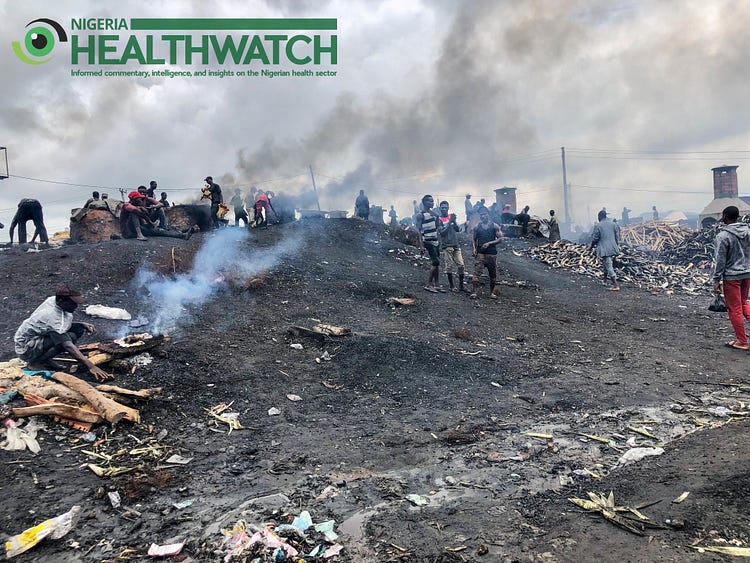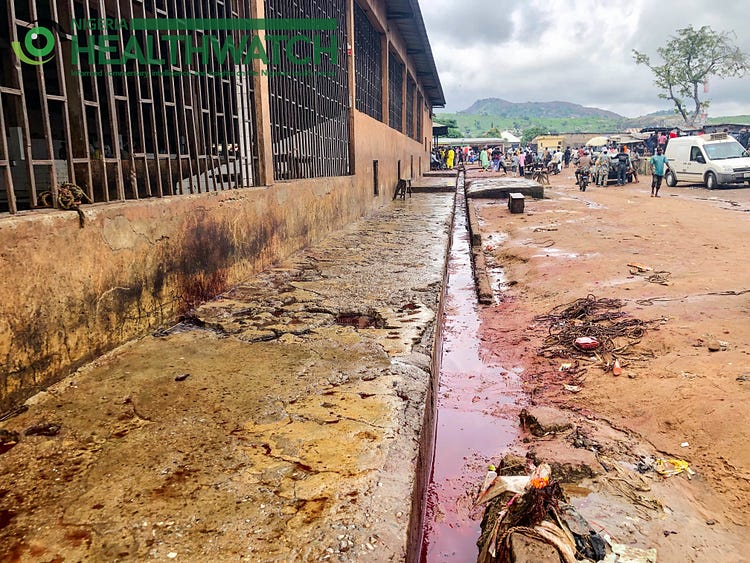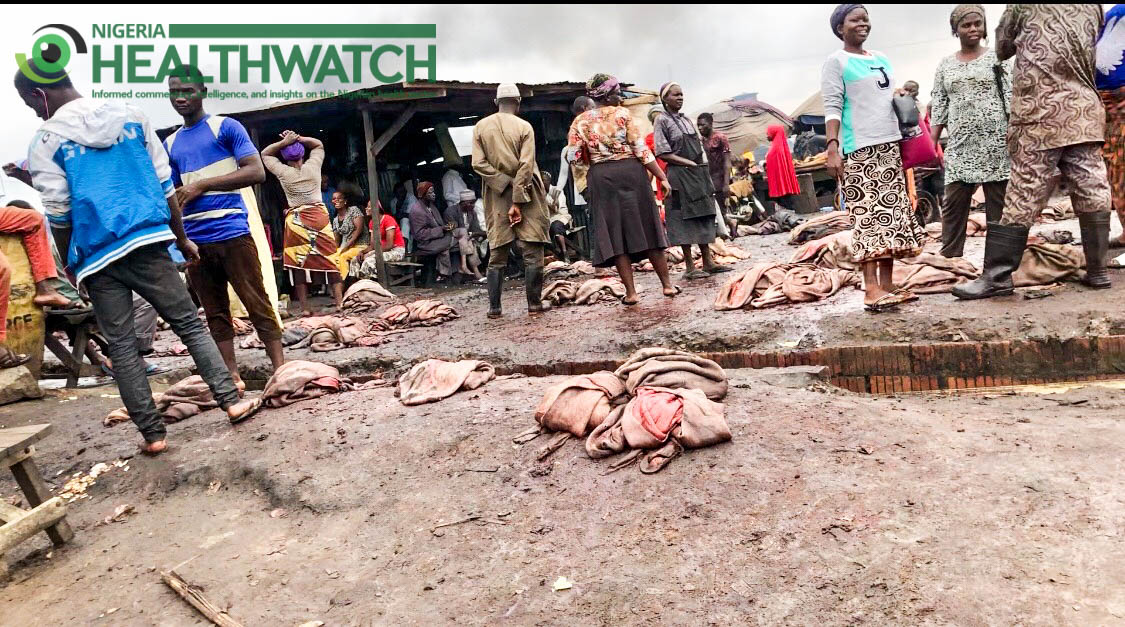Editor’s Note: The Nigeria Health Watch team recently visited abattoirs in Suleja and Dei-Dei, to learn how they are managed and tease out public health lessons that Nigeria needs to consider in order to safeguard its citizens from infectious diseases.
Suleja, Niger State, is a populous, cosmopolitan town on the outskirts of Abuja, the nation’s capital. At the end of the lone road that divides the town into two, thick smoke clouds the atmosphere. Cars and motorbikes compete for space on the narrow roads, with some motorbikes carrying different types and sizes of meat, from cow thighs to cow legs and cow heads. The meat is from Suleja’s biggest abattoir, a large open area just after the market, full of people and animals.
An unpleasant, nauseous smell greets anyone approaching the abattoir, where close to 400 animals, including cattle, rams and goats are slaughtered daily according to one of the butchers. It is not fenced, and animals like dogs and cats move about freely. The concrete floor inside the hall is completely covered with the blood and faeces of animals. The abattoir does not have any standard, potable water system and butchers rely on water sellers who bring the water in jerricans. People move in and out of the abattoir wearing the same shoes they wore outside and animals are cut open on the bare floor of the abattoir. The inadequate drainage system inside the abattoir is used to discard abdominal waste from the animals. Long ropes are used to hang intestines, and in various sections, large pieces of meat such as thighs and necks lay open on the ground where people walk, with flies freely perching between the meat and the nearby drainage system.

Perhaps the unhealthiest area in the abattoir is at the extreme end, where the popular delicacies of ‘kpomo’, cow head, cow tail and cow legs are processed. Removing the hair from the pieces involves burning followed by washing with hot water. In this part of the abattoir, which is engulfed in thick black smoke, countless animal skins together with the tails, legs and heads are laid side by side on the ground, black with ash. Tyres are burned to start the fire, and the skins and parts are thrown into the fire. Another option they use is to immerse the skins into hot water in large steel pots. The process is repeated continuously without changing the water in the pots.
These unhygienic practices do not only happen in the Suleja abattoir. Dei-Dei abattoir in the Federal Capital Territory (FCT) is smaller than Suleja’s, is fenced, and the slaughter hall is walled. There is also a small tank supplying water, with mini gutters surrounding it. Despite the better amenities, meat and animal parts are dumped at various places on the ground. The concrete floor and tiled walls in the slaughter hall are also stained with blood and faeces. Large chunks of intestinal offal are dumped at separate places in the abattoir including the slaughter halls. The exact same method of processing kpomo in Suleja is also used in Dei-Dei, where the cow tail and cow head is burnt in a fire using tyres or they are dipped into hot water.

Here are five takeaways we learned from visiting the two abattoirs:
1. Abattoirs are not regulated/managed by local councils despite existing guidelines:A staff member of the department of agriculture of the FCT council who spoke to Nigeria Health Watch said that at least one environmental officer is permanently posted to each of the four abattoirs under the area council to ensure that good hygienic practices are adhered to. But he said that the officer’s hands are practically tied, as he is usually hesitant to enforce the laws due to constant threat and intimidation from the butchers, who sometimes become aggressive. “The only way to enforce the right practices is to bring in the Police,’’ he said. At the time of publishing, attempts to reach authorities of the local government over the Suleija abattoir were not successful. If local authorities can impose levies on animals slaughtered, they should also enforce practices that will ensure the health of the citizens is not jeopardised through unhealthy practices by the butchers. Federal agencies such as the National Agency for Food, Drugs Administration and Control (NAFDAC) and the ministries of Agriculture and Environment must pay closer attention to how meat is processed in our abattoirs. They should support local authorities and police in enforcing healthy practices.
2. Unsanitary abattoirs are sources of infectious diseases that may go unreported: Research shows that unsanitary abattoirs are sources of public health concern because of the quality of meat sold in the markets. Infectious disease outbreaks such as cholera are frequent occurrences in Nigeria. Others such as parasitic worms and brucellosis that are not usually reported in an outbreak fashion are also common, and their sources can be traced to meat we consume. In addition to this is the risk of getting infected with the deadly bovine tuberculosis. Countries around the world have experienced disease outbreaks linked to contaminated foods at various times. An example is the 2017 Listeria outbreak in South Africa that led to the death of 200 people. The World Health Organisation estimates that about 91 million people fall ill every year due to foodborne diseases in Africa, of which more than 70% are diarrhoea related diseases which can be easily linked to the unhygienic ways of meat processing in abattoirs. Some of these practices not only expose Nigerians to infectious diseases through consumption of potentially contaminated meat, but also are risk factors for non-communicable diseases such as cancers by consuming kpomo that is exposed to particles produced from burning tyres.
3. Abattoirs generate income, but this is not used to efficiently manage them:
Dei-Dei is one of four abattoirs under the control of the Bwari local area council of the FCT. Every day, not less than 100 animals including at least ten cows, rams and sheep are slaughtered. Bwari council charges N500 for every cow slaughtered and N100 for every goat or ram, according to a staff member of the Department of Agriculture of the council, the supervising agency for the abattoirs, who asked to remain anonymous due to the sensitivity of the subject. More than N5 million is generated annually, estimating they slaughter 10 cows and 90 goats or rams daily. What are these monies used for? Who collects these monies? It only makes sense that a portion is invested back into the place generating the funds into improving the hygiene standard of the abattoirs.
4. Managers of abattoirs need training on infection, prevention and control protocols:
Beyond being venues for slaughtering meat, abattoirs are areas of public health concern, and should be treated accordingly. Those who manage them should understand that infectious diseases could easily spread from unhygienic conditions, more so from raw meat that will eventually be bought, cooked, and eaten. Abattoir managers should undergo basic training and certification in Infection, Prevention and Control (IPC) protocols. These protocols would allow them to understand how to ensure the environment where animals are killed is infection proof and ensure that those who work at the abattoirs as well as those who come there to purchase meat are practicing protective techniques that will prevent infections from spreading.

5. We must elevate the One Health approach to epidemic preparedness:
The state of our abattoirs underscores the need to more actively integrate food safety into the One Health approach to epidemic detection and preparedness. Research shows that abattoirs, if utilized effectively, play vital roles in disease surveillance, inspection of animals and meat, and could protect the population from zoonotic diseases which potentially might occur following the consumption of unhygienic, unsafe and unwholesome animal flesh. The One Health approach to epidemic preparedness emphasizes the interconnectedness between animal health and human health. We must consider how the way our animals are slaughtered may affect the health of citizens and take this into consideration when planning public health interventions.
Nigeria can learn from South Africa and the United Kingdom by enacting laws and guidelines that will provide direction for the entire meat processing industry, including abattoirs. In the South African law, there is a designated department in the Ministry of Agriculture responsible for regulating meat slaughtering and processing and every proposed abattoir must apply to the department for a license before it begins operations. The license is also renewable after five years after all hygiene and safety standards are satisfied. Licenses are also withdrawn if standards are not adhered to. The same procedure applies in the UK, where intending abattoir owners must apply and have their facilities inspected before they begin operations.

If Nigeria can enact and enforce similar laws, abattoirs like the ones in Suleja and Dei-Dei may well not be operating in the country or would be forced to improve hygiene standards to ensure that Nigerians are protected from disease.
The food industry, particularly the meat industry has always been and will continue to be a major factor in the daily life of Nigerians, and as such will be a determinant of health and wellbeing. Should a place of great public health importance like abattoirs be left unregulated, without regular and strident inspection by the authorities? The Nigerian government must consider the state of abattoirs and budget appropriately for their operations and regulation, as this is another way to prevent epidemics and protect the health of Nigerians.
Have you visited an abattoir in your community? Tell us about your experience! How is your local council enforcing standards? Use the hashtag #PreventEpidemicsNaija




Thanks for bringing this crucial topic to light. No one is unconcerned in the risks posed by unhygienic abattoir. Is there a way you can give this report more visibility? Can you send the pictures to Channels TV ireport? we need to keep this in the faces of those that need to respond until they do something about it.
2. It will also be good to share with the Council responsible for training Environmental Officers. There is a total failure of that cadre of profession in the public health space. The abattoirs can be used for pre-service training by making students rotate their and give lectures/health talks during their postings. This will be in addition to supporting advocacy to the Ministry of Agric and self-efforts on making functional boreholes and good drainage system in the abattoirs.
3. The area council chairman in Bwari Council and LGA Chairman in Suleja axis needs to also see this report.
4. Thank you again
This is good report, government has to take action that will prevent such distribution of poisonous meat, action that will not affect their business.
It’s the great problem that need early action.
It is very important topic, discussing it is timely going by how it is militating against the life of many Nigerians in both urban and rural areas. In most cases the abattoir was very good equip with tools that can make good hygiene of both the meat and workers but due to good training and awareness the workers will abandoned it and begin to slaughter animals by the roads or in a bush with flies roaming everywhere. While in some places, the environment itself is dangerous to be used as abattoir going by it unhealthiness but because of what one will called illiteracy of workers they would continue to do their business there, another problem facing communities more especially in the cities is how during both Sallah and Xmas most of people slaughter their animals by gutter, and if the water in the said gutter is not running soon an epidemic will be emerge.
Helo ,
I was shocked when I read the article. We are involved in, the designing , manufacturing, and installation of HALAL slaughterhouses. The latest one we have manufactured is at PORT HARCOURT in Nigeria. We will be interested in putting up modern abattoirs in any state of Nigeria as HELMAKS Company.